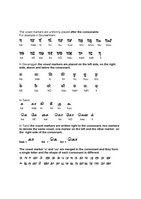RESEARCH INSTITUTE OF SOURASHTRA HERITAGE & IMMIGRATION [RISHI] was inaugurated on 5th April 2008 at Madurai. The inaugural function was held in Mepco Mini Auditorium, in the Chamber of Commerce & Industry premises at Kamarajar Salai Madurai at 10.30 a.m.
Smt.S.P.Geetha Bharathi rendered Prayer song. Mrs. Bhavana Kamalesh Joshipura, Ex.Mayor of Rajkot, Advocate, lighted the Mangal Deepam. Dr.T.R.Damodaran, Sanskrit Professor, Sourashtra College, Madurai delivered the welcome Address. Mrs. Radha Parasuram delivered the Presidential Addresss.
Felicitation speeches were delivered by Dr.Balvant Jani, Prof. & Head, Dept. of Gujarati, Saurashtra University, Rajkot, Dr.P.Zala, Dept.of English and Comparative Literature, Saurashtra University, Rajkot, Dr.Kalpak Trivedi, Pro-Chancellor, Saurashtra University, Rajkot, Dr.R.Suba Krishna, Central Institute of Indian Languages, Mysore and finally the inaugural address was delivered by Dr.Kamalesh P.Joshipura, Vice Chancellor, Saurashtra University, Rajkot, Gujarat. Vote of thanks was given by Sri T.L.Parasuram, Managing Trustee, RISHI.
The function came to an end after the singing of National Anthem by one and all.
Afterwards Lunch was served to all who attended the meeting.Encomiums were showered by the visiting Dignitaries on the Sourasahtras living in Tamil Nadu for preserving the Cultural Identity and Language. Nearly 1000 years of gap should be made good by deep researches undertaken by both the Scholars of Sourashtras living in Tamil Nadu and in Saurashtra region of Gujarat. For this purpose RISHI will be affiliated with Saurashtra University, Rajkot and exchange programs and conferences in both States will be conducted periodically. A Chair will be created in Saurashtra University, Rajkot exclusively for this purpose. The common features will be identified and the bondage between the people of Saurashtras of Gujarat and the Sourashtras living in other States especially in Tamil Nadu will be strengthened.
It is hoped that there is a bright future for the young scholars who want to do Research on Sourashtra Language, Literature, History, Culture etc. comparing the evidences available in both States. Sourashtra Language will be developed. Dictionaries, Grammars, Readers for teaching the language in Schools will be prepared.
SOURASHTRA SCRIPT will be made use to solve the Identity Crisis which is being noticed by the younger generation of Sourashtra Community.
UPAMANYU’S reply to K.V.Pathy.
I was told by the Managing Trustee that RISHI will use Sourashtra Script. It is to be seen whether they will tolerate the use of other scripts.
I am repeatedly emphasising that any script can be used. One should not impose his view on others. There are languages which use more than one script.
I am to contact the Scholars in Saurashtra University, Rajkot regarding their opinion.
Twice I missed my trip to Rajkot/Ahmadabad. I did meet the Vice Chancellor Dr.Kamalesh P.Joshipura on 4th night in Hotel Arthy, Madurai. I also met the other Professors Dr.Basvant Jani, Dr.P.Zala, Mrs.Bhavana Kamalesh Joshipura. I gave them my book 'Sourashtra Language, Literature and Script' my paper read in the Seminar held in Madurai by Madurai Kamaraj University and International School of Dravidian Linguistics, Trivandrum.
About 10 copies of 'Oral Literature of Saurashtrans' by Dr. Uchida Norihiko were given to Dr.T.R.Damodaran for onward transmission to the visiting Dignitaries to know our folk literature.
A copy of the catalogue of Palm Leaves and Paper manuscripts was also given to them to know what is available in our Museum and Library [which is yet to be opened]
I did not discuss the Sourashtra Script with them. But I was told by Dr.T.R.Damodaran that when they visited Rajkot, they wanted to learn the Sourashtra Script. I presume they might have thought that we are preserving our Sourashtra Language even after several centuries of our leaving the Home land, Saurashtra region of Gujarat. Similarly we are preserving our own Sourashtra Script. I think, after their deep study, they may come out with their opinion.
But it is quite natural that one is to use one's own script only instead of borrowed script.
If one argues that Devanagari is our own script, then he should explain what made Gujaratis to have their own script which is called MAHAJANI. And why T.M.Rama Rai and their followers did not use Devanagari Script for Sourashtra Language? Pros and cons can be argued. But nobody can impose his decision on others to use a particular script only.
One cannot deny the fact that Sourashtra Script will identify the Sourashtras without any difficulty. If we use Devanagari Script, then they have to break their head to decipher the language among twentytwo other languages using Devanagari.
A fine beginning is made and RISHI may bring far reaching changes in the lives of Sourashtras living in Tamil Nadu.
When we struggle hard to create a Chair for Sourashtram in Madurai Kamaraj University, the Vice Chancellor of Saurashtra University is going to create a Chair for Sourashtram spoken in Tamil Nadu once the RISHI is affiliated with Saurashtra University, Rajkot.
I myself am wondering why they were silent for such a long time. Perhaps they were waiting for the initiative by some organisation like RISHI. Even RISHI people were not much optimistic about the outcome before their maiden trip to Rajkot. They got encouraged by the eagerness shown by the Saurashtra University and hence they decided to depute another team of five people in which Thada Subramanyam and I were included; but unfortunately, due to my health problem I could not undertake the journey to Ahmadabad. Thada Subramanyam also could not visit Ahmadabad as he was tired in attending the Second Workshop on Sourashtram by CIIL which was held in Madurai from 19th March to 28th March 2008.
What CIIL, Mysore will do, that I am not aware. Dr.Suba Krishna assured that all assistance will be provided by CIIL for the development of Sourashtra language and financial assistance will be provided for the publication in Sourashtra Language. And now, after the coming in of RISHI, what Sourashtra Madhya Sabha will do? We have to wait and see.
UPAMANYU.


